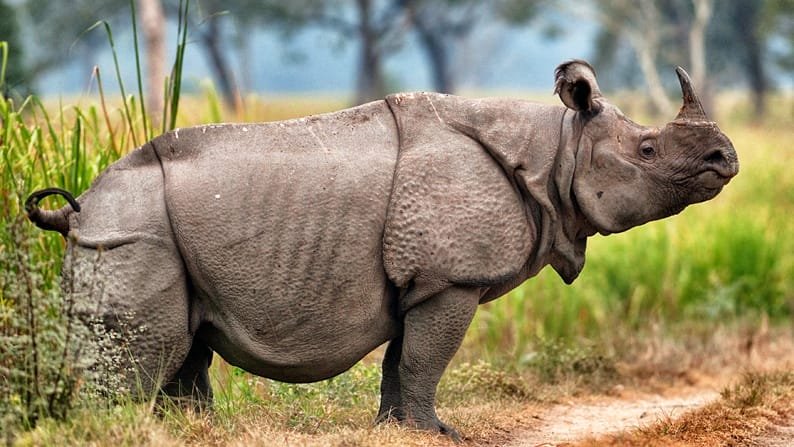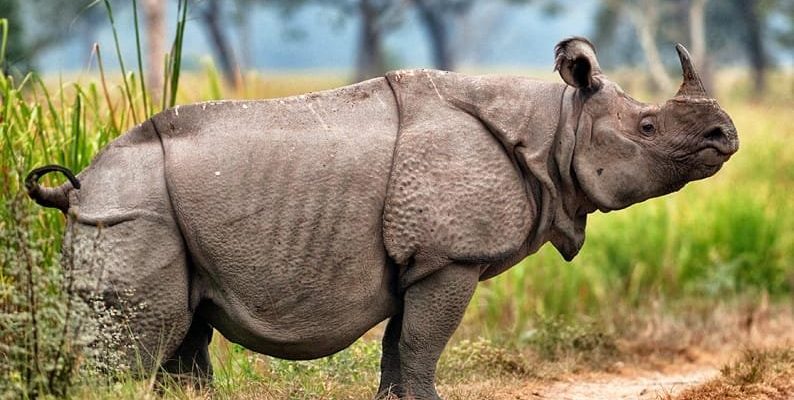
In this journey, we’ll explore everything from its unique habitat to its survival struggle. Think of it as a backstage pass to understanding not only the rhino but also the critical conservation efforts that are essential to its future. Are you ready to learn more about this incredible creature? Grab a cup of coffee, and let’s dive in!
1. The Rarest of All Rhinos
The Javan rhinoceros is often called the world’s rarest rhinoceros species, and for a good reason. With an estimated population of fewer than 80 individuals, this magnificent creature is on the brink of extinction. It’s like having a rare comic book—there are just not very many around, and each one is irreplaceable.
What makes the Javan rhino’s situation even more pressing is its very limited habitat. These rhinos are found solely in Ujung Kulon National Park in Indonesia, a lush area that has become their last refuge. In fact, if you picture a cozy corner with your favorite blankets and snacks, that’s what Ujung Kulon is for these rhinos—a safe space where they can (hopefully) thrive.
2. Unique Physical Features
When you think of rhinoceroses, you probably envision a massive animal with a thick, armored look. The Javan rhinoceros fits that description perfectly but with some unique twists. Unlike the more commonly known white rhino with its broad mouth, the Javan rhino has a more elongated face and a single horn that can grow up to 25 centimeters long. This horn isn’t just for show; it’s made of keratin, just like our hair and nails, and it helps them display dominance and attract mates.
These rhinos also have a distinctive coloration. Their skin appears in shades of gray, often marked with overlapping folds that give them a rugged appearance, like a living piece of armor! This texture isn’t just for aesthetics; it helps provide camouflage in their lush jungle environment. Picture them moving stealthily through the underbrush—those folds help them blend right in.
3. Feeding Habits and Diet
The Javan rhinoceros is a herbivore, feeding mainly on leaves, fruits, and shoots from the vegetation around it. Imagine a giant cow slowly munching its way through the forest; that’s pretty much how they roll! Their diet consists of hearty snacks like shrubs and small trees, which they can reach with their long tongues. How cool is that?
Interestingly, the Javan rhino has a preference for certain plants, meaning they can be quite picky eaters. They help maintain their ecosystem through selective feeding, similar to how you might choose certain berries over others when filling your bowl. This behavior contributes to the health of the forest, making their role crucial not just for their survival but for the environment as a whole.
4. Solitary Creatures
If you’re thinking of a pack of wild animals running around, you should know that Javan rhinoceroses are mostly solitary. They enjoy their own company, wandering through their territory alone. You might say they’re like introverts at a party—they prefer to keep to themselves while still keeping an eye on their surroundings.
However, they don’t completely shun social interaction. Males will sometimes share their space with females, especially during the mating season. Still, they generally maintain a respectful distance. It’s fascinating to think that, despite being such large creatures, they can be so solitary in nature.
5. Mating and Reproduction
When it comes to reproduction, Javan rhinos have a slow-paced approach. Female rhinos typically give birth to a single calf after a gestation period of around 16 months. That’s quite a commitment, right? Imagine waiting almost a year and a half for a new addition to your family!
The bond between a mother and her calf is incredibly strong. The mother will fiercely protect her young, nurturing it for up to three years before it starts to explore the world on its own. This lengthy care period means that each calf is very precious to the population, almost like a rare jewel you’d want to keep safe.
6. Conservation Efforts
Conservationists are tirelessly working to protect the Javan rhinoceros from extinction. Initiatives to safeguard their habitat, monitor populations, and minimize human conflict are crucial. It’s like trying to create a safe bubble for these rhinos in a world that is often too dangerous for them.
Ujung Kulon National Park has become the main focus of these efforts. Rangers patrol the area to protect the rhinos from poachers and habitat destruction. Protecting these animals is vital, as they help maintain the health of the ecosystem. Without them, the balance in their environment could be significantly disrupted. Every effort counts, and even small actions contribute to a larger mission of saving these magnificent creatures.
7. The Threat of Poaching
Poaching is one of the biggest threats to the Javan rhinoceros. Demand for rhino horns in traditional medicine and as a luxury item drives illegal hunting. Honestly, it’s heartbreaking. Rhino horns are often viewed as status symbols, leading to widespread poaching that threatens all rhino species, including the Javan.
Efforts to combat poaching are ongoing. Education about the importance of rhinos and stricter law enforcement can help deter illegal activities. It’s crucial for people to understand that every rhino lost is a loss for biodiversity. Imagine if your favorite book was taken out of every library; that’s how it feels when a species faces extinction.
8. Cultural Significance
The Javan rhinoceros holds a unique place in local folklore and culture. In many Indonesian communities, these majestic animals are symbols of strength and resilience. You might think of them as the gentle giants of the forest, embodying both power and grace.
These creatures also play an essential role in ecotourism, attracting nature lovers and researchers from around the world. By learning about and experiencing the life of the Javan rhinoceros, people can gain a deeper appreciation for wildlife conservation. The more people know about this incredible animal, the stronger the push for its protection becomes.
9. Habitat and Range
The Javan rhinoceros thrives in tropical rainforests, specifically in Ujung Kulon National Park. This park is a UNESCO World Heritage site, showcasing a diverse ecosystem filled with various plant and animal species. Imagine a lush green paradise where every corner is bursting with life—that’s their home!
The thick vegetation provides shelter and food while maintaining the humidity that these rhinos need. They prefer areas near water sources, as they love to wallow in mud, which helps keep their skin healthy and cool. Think of it like a natural spa day! However, their limited range makes them incredibly vulnerable to environmental changes and human activities.
10. The Future of the Javan Rhinoceros
The future of the Javan rhinoceros remains uncertain but hopeful. Conservationists continue to work hard to raise awareness and protect these rare animals. Here’s the thing: every person can contribute to wildlife conservation in some way, whether it’s through support, education, or direct action.
Organizations worldwide are collaborating to ensure that the Javan rhinoceros has a fighting chance. They’re exploring methods like habitat restoration and breeding programs. Let’s not forget: every time we learn something new about this fascinating species, we’re one step closer to ensuring its survival for generations to come. It’s not just about saving an animal; it’s about preserving a piece of our planet’s heritage.
In conclusion, the Javan rhinoceros is truly one of nature’s wonders. By understanding and appreciating these creatures, we can inspire more people to join the fight for their survival. Let’s work together to keep the memory of the Javan rhino alive and thriving!

